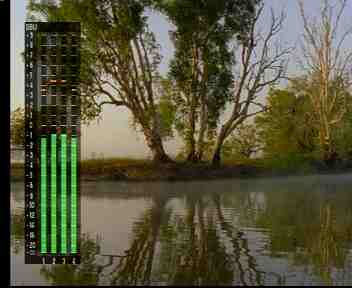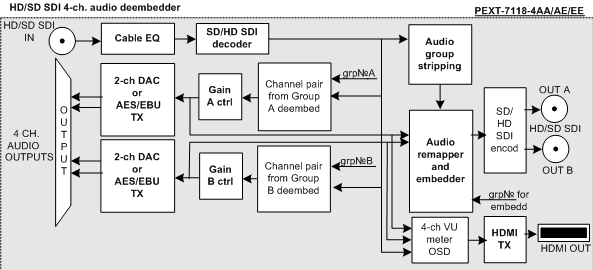|
Main / SDI embedders and deembedders / PEXT-7118
| PEXT-7118 HD/SD SDI video, audio deembedders with HDMI monitor output |
PROFLEX™ PEXT-7118 series HD/SD SDI deembedders accept the SD/HD SDI stream to deembed up to four audio channels and one RS-232 data signal from it.
The PEXT-7118 module occupies one slot in the PROLFEX 1U/3U racks so that up to four deembedders fit into a 1U rack and up to fifteen into a 3U rack.
The output audio signal may be in any standard: an analog, AES or combination of both. These modificatiuons are designated the following model indexes:
- four analog balanced outputs (24-bits DAC) – the "AA" index, (f.e. PEXT-7118-4AA)
- two analog balanced outputs and one balanced AES/EBU output (4 channels in total) – the "AE" index, (f.e. PEXT-7118-4AE)
- two balanced AES/EBU outputs (4 channels) – the "EE" index, (f.e. PEXT-7118-4EE)
The PEXT-7118 deembedders are featuring the monitoring HDMI output with the OSD of the bar-graph audio level meters (quasi-peak and VU).

PEXT-7118 rear panel:

PEXT-7118 simplified schematic diagram:

PEXT-7118 accepts HD/SD SDI input signals. SDI input is equalized, decoded into a 10-bits 4:2:2 stream which is processed by a video/audio processor.
The video/audio processor deembedds the audio streams. Output audio may be an analog ("AA" model index), digital AES/EBU ("EE" model index) or combination of both formats ("AE" model index).
Features:
- HD/SD SDI compliance
- electrical and HDMI outputs are available simultaneously
- automatic cable equalizer on SDI input
- built-in 1kHz test generator
- built-in color bar generator
- signal loss indicator
- EDH/CRC status indicators
- automatic detection and indication of an embedded audio in the input SDI signal
- audio group selection for deembedding
- audio channel mapping and/or remapping
- audio group and ancillary data stripping/editing capability
- presettable audio gain
- bargraph audio level meter (quazi-peak and UV) OSD on HDMI monitor output
- compatibility with a single-signal, WDM and CWDM optical systems
- an analog, AES/EBU or combination of audio outputs
- 24-bits audio DAC
Technical specifications
- Inputs
- SDI
| Standard compliance |
SMPTE 292M (HD SDI) |
50I/1920*1080(2640*1125), 1080I/50 |
59.94I/1920*1080(2200*1125), 1080I/59.94 |
60I/1920*1080(2200*1125), 1080I/60 |
25P/1920*1080(2640*1125), 1080P/25 |
29.97P/1920*1080(2200*1125), 1080P/50 |
30P/1920*1080(2200*1125), 1080P/30 |
50P/1280*720(1980*750), 720P/50 |
59.94I/1280*720(1650*750), 720I/59.94 |
60P/1280*720(1650*750), 720P/59.94 |
| SMPTE 259M (SD SDI) |
50I/720*576, 625I/50 |
59.94I/720*480, 525I/59.94 |
| Input impedance, connector type |
75 Ohm, BNC |
| return loss |
better than 14dB at 1.485GHz |
| Automatic cable equalization |
(Belden 1694A or similar), up to 75m for HD SDI (1.485Gbps) or 300m for SD SDI (270Mbps) |
- Outputs
- Analog AUDIO
| Connector |
DB-15 |
| output impedance |
less than 50 Ohm |
| output type |
balanced |
| 0 dB FS level |
+18dB (+24dB jumper-selectable) |
| Dynamic range |
better than 100dB |
| DAC |
24-bits at 48kHz |
| Harmonic distortions and noise |
less than 0,006% |
| audio gain presets |
±6dB with 0.2dB steps |
- AES/EBU
| output type |
transformer balanced |
| Connector type |
DB-15 |
| Amplitude |
3.0V at 110 Ohm |
| audio gain presets |
±6dB |
- HDMI
| standard compliance |
as per input signal standard |
PEXT-7118 controls and indicators:

The MODE button toggles through all the modes, the UP and DOWN buttons edit them.
- INP - input signal format selection
- BARS - built-in color bar generator ON/OFF
- ASSIGN A/B GROUP/CH - audio channel outputs mapping
- GAIN A/B - the audio gain presets in a selected stereo pair or AES signal
- TON - the built-in 1kHz test tone generator ON/OFF
- NEW GROUP - a group number select/disable for a remapped audio
- ANC STRIP - ancillary data stripping ON/OFF
- VU METR - the VU-meter controls (ON/OFF, scale type, placement on the screen)
Status indicators:
- EDH/CRC MIN/HOUR - lit if two or more EDH/CRC errors were detected within one hour/minute interval
- AUD DET - lit when an input SDI has the embedded audio
- LOSS - lit when SDI input is lost
- BARS - lit when the color bars are being inserted
Configuring the PEXT-7118 deembedder
The input signal format selection:
Toggling the MODE button select the INP mode. Pressing the UP and DOWN buttons select an input signal standard.
- A## – input signal standard autodetection:
- A62 - standard definition signal (625I/50)
- A52 - standard definition signal (525I/60)
- A80 - high definition signal (1080I/50 or 1080P/25)
- A80. - high definition signal (1080I/60 or 1080P/30 or 1080P/29.97)
- A72 - high definition signal (720P/50)
- A72. - high definition signal (720P/60 or 720P/59.94)
- manually-preselectable standards:
- 625 - only standard definition signal accepted (625I/50)
- 80 I – only high definition signal accepted (1080I/50)
- 720 – only high definition signal accepted (720P/50)
- 525 - only standard definition signal accepted (525I/59.94)
- 80 I. – only high definition signal accepted (1080I/60)
- 720. – only high definition signal accepted (720P/60)
- 80 P – only high definition signal accepted (1080P/25)
- 80 P. – only high definition signal accepted (1080P/30)
- 80.I. – only high definition signal accepted (1080I/59.94)
- 72.0. – only high definition signal accepted (720P/59.94)
- 80.P. – only high definition signal accepted (1080P/29.97)
Built-in color bar generator ON/OFF:
Toggle the BARS button. The built-in color bar generator is disabled/enabled with the standard preselected in the INP configuration step. No input video is required. The 1kHz test-tone or an external audio embedding is possible.
The audio group number selection for deembedding:
Each audio group consists of four channels (1 to 4) which comprise two channel pairs (1/2 and 3/4). An SDI stream may embed up to four groups, i.e. up to sixteen audio channels.
Toggling the MODE button select the ASSIGN A GROUP or ASSIGN B GROUP mode. Pressing the UP and DOWN buttons select an audio group number (1, 2, 3 and 4 groups are available).
Pressing the MODE button again select the ASSIGN A CH or ASSIGN B CH mode. Pressing the UP and DOWN buttons select audio channels for outputs A or B respectively. The most significant digit on the LED display shows the group number, the two least significant ones display the channels' numbers:
#1/2, #2/1, #1/1, #2/2, #3/4, #4/3, #3/3, #4/4, where # denotes the group number.
The audio gain presets:
Toggling the MODE button select the GAIN A or GAIN B mode. Pressing the UP and DOWN buttons select gain for the channel pair. The audio gain range: ±6dB in 0.2dB increments. The simultaneous depression of the UP and DOWN buttons resets the gain to 0dB.
- #.# – a channel has positive gain of #.#dB
- — #.# – a channel has negative gain of #.#dB
The 1kHz test tone operation:
Toggling the MODE button select the TON mode. Pressing the UP and DOWN buttons select a channel to insert the 1kHz signal into.
- OF - the test signal is OFF in all channels
- On - the test signal is ON in all channels
- 01, 02, 12, 03, 04, 34 - the test signal appears in respective channel(s)
A new audio group composition ON/OFF:
Toggling the MODE button select the NEW GROUP mode. Pressing the UP and DOWN buttons select an audio group number to embed the channels currently assigned for A and B outputs.
- ban - a new group is neither composed nor embedded
- 1 - the channels currently assigned for A and B outputs are embedded in the 1st group
- 2 - the channels currently assigned for A and B outputs are embedded in the 2nd group
- 3 - the channels currently assigned for A and B outputs are embedded in the 3rd group
- 4 - the channels currently assigned for A and B outputs are embedded in the 4th group
A group number conflict is possible if a new group is assigned the same number that is already present in an input SDI. The main LED indicator will show the nA# in the NEW GROUP mode, where # is the actual clashing number. To resolve the conflict either assign another new group number, or use the ANC STRIP mode to erase the clashing group from the input SDI stream.
The ancillary data stripping:
In the case of a conflict between a selected audio group number and an input SDIembedded stream one may resolve it by stripping the input SDI signal. Toggling the MODE button select the ANC STRIP mode.Pressing the UP or DOWN buttons enable the stripping mode.
- ANC STRIP OF - the ancillary data stripping is OFF
- ANC STRIP On - the ancillary data stripping is ON (in all groups simultaneously)
- ANC STRIP AU# - the automatic ancillary data stripping mode: the group number preselected in the NEW GROUP is replaced by the audio being embedded. The display shows the actual group number:
- ANC STRIP AU1 - the group number 1 is erased from the input SDI signal
- ANC STRIP AU2 - the group number 2 is erased from the input SDI signal
- ANC STRIP AU3 - the group number 3 is erased from the input SDI signal
- ANC STRIP AU4 - the group number 4 is erased from the input SDI signal
- ANC STRIP 1 - the ancillary data stripping is ON in group #1 only
- ANC STRIP 2 - the ancillary data stripping is ON in group #2 only
- ANC STRIP 3 - the ancillary data stripping is ON in group #3 only
- ANC STRIP 4 - the ancillary data stripping is ON in group #4 only
Selecting the VU METR modes:
Toggling the MODE button select the VU METR mode. Pressing the UP and DOWN buttons adjust the horizontal position of the VU-meter OSD. Pressing the MODE and DOWN buttons simultaneously switches the OSD off (the indicator shows "On" -> "OF"). Pressing the MODE and UP buttons simultaneously selects the VU-meter scale mode:
- EBU scale, 0dBfs corresponds to +18 dBU (indicator shows "FS")
- quazi-analog scale, 0dBU corresponds to 0,775VRMS (indicator shows "db")
The remote control and management from a PC
All the PROFLEX™ modules are remote controllable from a PC. This facility is available if a rack is fitted with a CPU module (ordered separately).
|